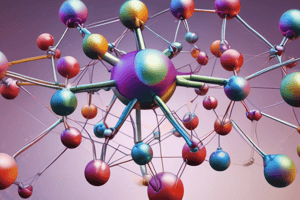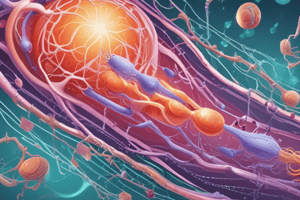Podcast
Questions and Answers
Within the context of antagonistic hallmarks of aging, which of the following scenarios best exemplifies the intricate interplay between mitochondrial dysfunction and deregulated nutrient sensing, leading to accelerated aging phenotypes?
Within the context of antagonistic hallmarks of aging, which of the following scenarios best exemplifies the intricate interplay between mitochondrial dysfunction and deregulated nutrient sensing, leading to accelerated aging phenotypes?
- A transient decrease in reactive oxygen species (ROS) production alongside enhanced mitophagy, resulting in improved cellular homeostasis and longevity.
- A simultaneous upregulation of sirtuin activity and enhanced mitochondrial fusion, leading to improved mitochondrial function, reduced oxidative damage, and extended cellular lifespan.
- A sustained increase in insulin-like growth factor 1 (IGF-1) signaling coupled with enhanced mitochondrial biogenesis, promoting cellular proliferation and delaying senescence.
- An acute downregulation of AMP-activated protein kinase (AMPK) activity accompanied by reduced mitochondrial membrane potential, triggering apoptosis and preventing the propagation of senescent cells.
- A chronic state of mitochondrial oxidative stress inducing mTOR activation, leading to impaired autophagy, accumulation of damaged proteins, and accelerated cellular senescence. (correct)
Considering the primary hallmarks of aging, how does epigenetic alteration most critically undermine cellular function and contribute to the aging process, especially in the context of tissue-specific decline?
Considering the primary hallmarks of aging, how does epigenetic alteration most critically undermine cellular function and contribute to the aging process, especially in the context of tissue-specific decline?
- By promoting global DNA methylation, leading to enhanced transcriptional fidelity and improved cellular differentiation.
- By facilitating the stable inheritance of beneficial epigenetic marks, promoting cellular adaptation to age-related stressors.
- By enhancing microRNA-mediated gene silencing, leading to selective suppression of pro-aging pathways and extended cellular lifespan.
- By inducing site-specific histone acetylation, resulting in increased expression of stress response genes and enhanced cellular resilience.
- By disrupting chromatin structure and organization, leading to aberrant gene expression patterns and impaired cellular identity and function. (correct)
In the context of cellular senescence as an antagonistic hallmark of aging, which mechanism most effectively mitigates the deleterious effects of senescent cells on tissue homeostasis and organismal health?
In the context of cellular senescence as an antagonistic hallmark of aging, which mechanism most effectively mitigates the deleterious effects of senescent cells on tissue homeostasis and organismal health?
- Increased secretion of growth factors by senescent cells, promoting tissue repair and regeneration in adjacent cells.
- Activation of autophagy in senescent cells, leading to efficient removal of damaged organelles and prolonged cellular survival.
- Pharmacological or genetic ablation of senescent cells, preventing the accumulation of senescence-associated secretory phenotype (SASP) factors and restoring tissue function. (correct)
- Enhanced expression of anti-apoptotic proteins in senescent cells, preventing premature cell death and maintaining tissue integrity.
- Upregulation of pro-inflammatory cytokines by senescent cells, enhancing immune surveillance and clearance of pre-cancerous cells.
Given the interconnectedness of the integrative hallmarks of aging, which intervention strategy would most comprehensively address both stem cell exhaustion and altered intercellular communication to promote tissue rejuvenation and systemic healthspan extension?
Given the interconnectedness of the integrative hallmarks of aging, which intervention strategy would most comprehensively address both stem cell exhaustion and altered intercellular communication to promote tissue rejuvenation and systemic healthspan extension?
Among the primary hallmarks of aging, genomic instability plays a pivotal role. Which molecular mechanism, if selectively enhanced, could paradoxically exacerbate genomic instability-driven aging phenotypes despite its intended DNA damage repair function?
Among the primary hallmarks of aging, genomic instability plays a pivotal role. Which molecular mechanism, if selectively enhanced, could paradoxically exacerbate genomic instability-driven aging phenotypes despite its intended DNA damage repair function?
Given the intricate interplay between immunesenescence and chronic inflammatory processes, which of the following best delineates the nuanced relationship between reduced adaptive immune capacity and the pathogenesis of age-related diseases within the context of inflammaging?
Given the intricate interplay between immunesenescence and chronic inflammatory processes, which of the following best delineates the nuanced relationship between reduced adaptive immune capacity and the pathogenesis of age-related diseases within the context of inflammaging?
Considering the multifaceted nature of intercellular communication, and acknowledging the distinct mechanisms of paracrine, endocrine, and synaptic signaling, which of the following statements most accurately reflects the comprehensive impact of altered intercellular communication in the context of organismal aging?
Considering the multifaceted nature of intercellular communication, and acknowledging the distinct mechanisms of paracrine, endocrine, and synaptic signaling, which of the following statements most accurately reflects the comprehensive impact of altered intercellular communication in the context of organismal aging?
Given the established role of inflammaging as a chronic, low-grade systemic inflammation in the pathogenesis of age-related diseases, and considering the interplay between senescent cells and the dysfunctional immune system, which of the following statements most precisely encapsulates the etiological paradox of inflammaging?
Given the established role of inflammaging as a chronic, low-grade systemic inflammation in the pathogenesis of age-related diseases, and considering the interplay between senescent cells and the dysfunctional immune system, which of the following statements most precisely encapsulates the etiological paradox of inflammaging?
Considering the primary hallmarks of aging – genomic instability, telomere attrition, epigenetic alterations, and loss of proteostasis – and recognizing their distinct yet interconnected mechanisms, which of the following accurately characterizes the hierarchical relationship and consequential cascade initiating the aging phenotype?
Considering the primary hallmarks of aging – genomic instability, telomere attrition, epigenetic alterations, and loss of proteostasis – and recognizing their distinct yet interconnected mechanisms, which of the following accurately characterizes the hierarchical relationship and consequential cascade initiating the aging phenotype?
Given the integrative hallmarks of aging – cellular senescence, stem cell exhaustion, and altered intercellular communication – and their role in mediating systemic aging phenotypes, which of the following statements most accurately describes the holistic and emergent properties arising from the convergence of these hallmarks at the organismal level?
Given the integrative hallmarks of aging – cellular senescence, stem cell exhaustion, and altered intercellular communication – and their role in mediating systemic aging phenotypes, which of the following statements most accurately describes the holistic and emergent properties arising from the convergence of these hallmarks at the organismal level?
Given the interplay between cellular senescence, stem cell exhaustion, and immune cell activation depicted, which of the following scenarios would MOST critically undermine tissue homeostasis and accelerate organismal aging?
Given the interplay between cellular senescence, stem cell exhaustion, and immune cell activation depicted, which of the following scenarios would MOST critically undermine tissue homeostasis and accelerate organismal aging?
Considering the dual role of cellular senescence in tumor suppression and age-related pathology, which of the following therapeutic strategies would be LEAST likely to yield favorable outcomes in extending healthspan while minimizing cancer risk?
Considering the dual role of cellular senescence in tumor suppression and age-related pathology, which of the following therapeutic strategies would be LEAST likely to yield favorable outcomes in extending healthspan while minimizing cancer risk?
In the context of stem cell exhaustion and accumulating senescent cells with age, which of the following interventions would MOST directly address the underlying mechanisms driving this phenomenon, leading to improved tissue regeneration and reduced age-related pathologies?
In the context of stem cell exhaustion and accumulating senescent cells with age, which of the following interventions would MOST directly address the underlying mechanisms driving this phenomenon, leading to improved tissue regeneration and reduced age-related pathologies?
Considering the complex interplay amongst stress, replication, immune cell activation, and accumulation of senescent cells, which intervention would MOST likely have the LEAST beneficial impact on overall healthspan and aging?
Considering the complex interplay amongst stress, replication, immune cell activation, and accumulation of senescent cells, which intervention would MOST likely have the LEAST beneficial impact on overall healthspan and aging?
Given the intricate relationship between SASPs, inflammaging, and the accumulation of senescent cells, which of the following scenarios would MOST potently exacerbate age-related cognitive decline?
Given the intricate relationship between SASPs, inflammaging, and the accumulation of senescent cells, which of the following scenarios would MOST potently exacerbate age-related cognitive decline?
Considering the depicted cellular transitions and acknowledging the pleiotropic nature of cellular senescence, which of the following statements most accurately delineates a critical distinction between normal proliferating cells and cells undergoing senescence, specifically concerning their engagement in tissue homeostasis?
Considering the depicted cellular transitions and acknowledging the pleiotropic nature of cellular senescence, which of the following statements most accurately delineates a critical distinction between normal proliferating cells and cells undergoing senescence, specifically concerning their engagement in tissue homeostasis?
In the context of age-related physiological decline, and given stem cell exhaustion as an integrative hallmark, which of the following mechanisms most precisely elucidates the etiology of stem cell exhaustion, considering both intrinsic and extrinsic factors influencing stem cell fate?
In the context of age-related physiological decline, and given stem cell exhaustion as an integrative hallmark, which of the following mechanisms most precisely elucidates the etiology of stem cell exhaustion, considering both intrinsic and extrinsic factors influencing stem cell fate?
Considering the intricate dynamics of intercellular communication and its modulation by senescent cells, which of the following best describes the paracrine signaling paradigm emanating from senescent cells that most significantly contributes to tissue dysfunction and age-related pathology?
Considering the intricate dynamics of intercellular communication and its modulation by senescent cells, which of the following best describes the paracrine signaling paradigm emanating from senescent cells that most significantly contributes to tissue dysfunction and age-related pathology?
Given the age-dependent decline in immune surveillance and the role of the immune system in senescent cell clearance, which of the subsequent scenarios most accurately depicts the consequence of impaired immune-mediated senescent cell clearance in the context of tissue aging and associated pathologies?
Given the age-dependent decline in immune surveillance and the role of the immune system in senescent cell clearance, which of the subsequent scenarios most accurately depicts the consequence of impaired immune-mediated senescent cell clearance in the context of tissue aging and associated pathologies?
Considering the dualistic nature of cellular senescence—both beneficial in certain contexts (e.g., wound healing) and detrimental in others (e.g., age-related disease)—which of the following most accurately encapsulates the critical determinant distinguishing between the physiological versus pathological consequences of senescent cell accumulation?
Considering the dualistic nature of cellular senescence—both beneficial in certain contexts (e.g., wound healing) and detrimental in others (e.g., age-related disease)—which of the following most accurately encapsulates the critical determinant distinguishing between the physiological versus pathological consequences of senescent cell accumulation?
Given the intricate interplay between IGF-1 signaling and cellular processes, under what specific condition would the concurrent activation of both mTOR and autophagy pathways most likely occur?
Given the intricate interplay between IGF-1 signaling and cellular processes, under what specific condition would the concurrent activation of both mTOR and autophagy pathways most likely occur?
In the context of cellular senescence and its intricate relationship with IGF-1 signaling, which of the following interventions would most likely mitigate the pro-senescent effects mediated by chronic IGF-1 stimulation?
In the context of cellular senescence and its intricate relationship with IGF-1 signaling, which of the following interventions would most likely mitigate the pro-senescent effects mediated by chronic IGF-1 stimulation?
Considering the multifaceted roles of SIRT1, under what specific condition would its activation least likely result in increased longevity?
Considering the multifaceted roles of SIRT1, under what specific condition would its activation least likely result in increased longevity?
Given the opposing roles of IGF-1 and autophagy in cellular homeostasis, which scenario would most critically depend on a precisely balanced regulation of these pathways to prevent pathological consequences?
Given the opposing roles of IGF-1 and autophagy in cellular homeostasis, which scenario would most critically depend on a precisely balanced regulation of these pathways to prevent pathological consequences?
In the context of age-related diseases and declining cellular function, which of the following interventions targeting the IGF-1/SIRT1 axis would most likely offer the most comprehensive protection against multiple age-related pathologies?
In the context of age-related diseases and declining cellular function, which of the following interventions targeting the IGF-1/SIRT1 axis would most likely offer the most comprehensive protection against multiple age-related pathologies?
Considering the intricate link between nutrient sensing and the IGF-1 pathway, under what circumstances would a paradoxical increase in both protein synthesis and autophagy be observed simultaneously?
Considering the intricate link between nutrient sensing and the IGF-1 pathway, under what circumstances would a paradoxical increase in both protein synthesis and autophagy be observed simultaneously?
Given that cellular senescence is characterized by a complex interplay of factors, which specific alteration in IGF-1 signaling would most likely drive the transition of a pre-senescent cell toward a fully established senescent phenotype?
Given that cellular senescence is characterized by a complex interplay of factors, which specific alteration in IGF-1 signaling would most likely drive the transition of a pre-senescent cell toward a fully established senescent phenotype?
Considering the contrasting effects of IGF-1 and SIRT1 on cellular fate, which specific experimental manipulation would be most effective in promoting cellular survival and stress resistance under conditions of severe nutrient deprivation?
Considering the contrasting effects of IGF-1 and SIRT1 on cellular fate, which specific experimental manipulation would be most effective in promoting cellular survival and stress resistance under conditions of severe nutrient deprivation?
In the context of mitochondrial theory of aging, what is the most critical distinction between the compensatory increase in mitochondrial activity during middle age and the declined mitochondrial activity in old age?
In the context of mitochondrial theory of aging, what is the most critical distinction between the compensatory increase in mitochondrial activity during middle age and the declined mitochondrial activity in old age?
Considering the interplay between deregulated nutrient sensing pathways and mitochondrial dysfunction in aging, which of the following scenarios would most likely lead to an accelerated aging phenotype?
Considering the interplay between deregulated nutrient sensing pathways and mitochondrial dysfunction in aging, which of the following scenarios would most likely lead to an accelerated aging phenotype?
How does the balance between mitochondrial fusion and fission events change with age, and what is the functional significance of this shift in the context of cellular aging?
How does the balance between mitochondrial fusion and fission events change with age, and what is the functional significance of this shift in the context of cellular aging?
Given the roles of autophagy in cellular maintenance, what specific aspect of mitochondrial dysfunction would be LEAST effectively addressed by enhanced autophagic activity?
Given the roles of autophagy in cellular maintenance, what specific aspect of mitochondrial dysfunction would be LEAST effectively addressed by enhanced autophagic activity?
Which of the following interventions would be most effective in simultaneously addressing both deregulated nutrient sensing and mitochondrial dysfunction to promote longevity?
Which of the following interventions would be most effective in simultaneously addressing both deregulated nutrient sensing and mitochondrial dysfunction to promote longevity?
What is the most plausible mechanism by which age-related decline in mitochondrial membrane potential contributes to systemic aging?
What is the most plausible mechanism by which age-related decline in mitochondrial membrane potential contributes to systemic aging?
How does age-related impairment of mitochondrial protein import mechanisms contribute to the progression of cellular senescence and organismal aging?
How does age-related impairment of mitochondrial protein import mechanisms contribute to the progression of cellular senescence and organismal aging?
Considering the role of inflammation signals and senescent phenotypes in the context of stage of life and different roles, what intervention would MOST effectively target both aspects to extend healthspan?
Considering the role of inflammation signals and senescent phenotypes in the context of stage of life and different roles, what intervention would MOST effectively target both aspects to extend healthspan?
Flashcards
Cellular Senescence Purpose
Cellular Senescence Purpose
Stops damaged cells from progressing and triggers their removal.
Age-Related Senescence
Age-Related Senescence
Increased senescent cells due to higher production, slower clearance, or stem cell exhaustion.
Damaged Cell Replication
Damaged Cell Replication
Uncontrolled replication of a damaged cell that can lead to cancer.
SASPs (Senescence-Associated Secretory Phenotypes)
SASPs (Senescence-Associated Secretory Phenotypes)
Signup and view all the flashcards
Inflammageing
Inflammageing
Signup and view all the flashcards
Genomic Instability
Genomic Instability
Signup and view all the flashcards
Telomere Attrition
Telomere Attrition
Signup and view all the flashcards
Epigenetic Alteration
Epigenetic Alteration
Signup and view all the flashcards
Loss of Proteostasis
Loss of Proteostasis
Signup and view all the flashcards
Mitochondrial Dysfunction
Mitochondrial Dysfunction
Signup and view all the flashcards
Senescent Cells
Senescent Cells
Signup and view all the flashcards
Intercellular Communication
Intercellular Communication
Signup and view all the flashcards
Immune System (Clearance)
Immune System (Clearance)
Signup and view all the flashcards
Stem Cell Exhaustion
Stem Cell Exhaustion
Signup and view all the flashcards
Self-Renewal
Self-Renewal
Signup and view all the flashcards
mTOR Pathway
mTOR Pathway
Signup and view all the flashcards
SIRTs Pathway
SIRTs Pathway
Signup and view all the flashcards
SIRT1 (Sirtuin 1)
SIRT1 (Sirtuin 1)
Signup and view all the flashcards
Autophagy
Autophagy
Signup and view all the flashcards
Cellular Senescence
Cellular Senescence
Signup and view all the flashcards
IGF-1
IGF-1
Signup and view all the flashcards
Mitochondria Theory of Aging
Mitochondria Theory of Aging
Signup and view all the flashcards
ROS (Reactive Oxygen Species)
ROS (Reactive Oxygen Species)
Signup and view all the flashcards
Deregulated Nutrient Sensing
Deregulated Nutrient Sensing
Signup and view all the flashcards
IIS (Insulin/IGF-1 Signaling) pathway
IIS (Insulin/IGF-1 Signaling) pathway
Signup and view all the flashcards
FOXO
FOXO
Signup and view all the flashcards
IR
IR
Signup and view all the flashcards
Immunesenescence
Immunesenescence
Signup and view all the flashcards
Paracrine Signaling
Paracrine Signaling
Signup and view all the flashcards




